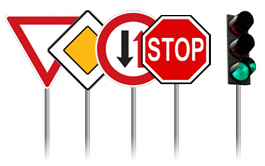(Re)learning to drive through Brno

Pop quiz! Three questions, in Czech, from the official driving test. Translations and answers will be provided below.
1. Při odbočování řidič nesmí:
A Ohrozit řidiče jedoucí za ním a musí dbát zvýšené opatrnotsi.
B Omezit řidiče jedoucí za ním.
2. Od řidiče motorového vozidla podezřelého ze spáchání přestupku proti bezpečnosti a plynulosti provozu na pozemních komunikacích, u kterého je důvodné podezření, že se bude vyhýbat přestupkovému řízení, je oprávněn vybrat kauci:
A Policista.
B Policista a strážník obecní policie.
3. Provozovatel motorového vozidla odpovídá:
A Pouze za škodu, která byla vyvolána porušením povinností řidiče tohoto vozidla.
B Za škodu vyvolanou zvláštní povahou provozu motorového vozidla.
These are three questions from the written part of the Czech driver’s test that I took on Aug. 31, 2014. I decided to take the test in Czech in order to practice the language while becoming a legal driver. There were many times that I regretted that ambitious plan.
Taking the driving test in Brno is an interesting experience. It takes time and costs money, but parts of it are genuinely fun. If you live here, you have to get a local driving license in order to drive legally. Tourists with rental cars are fine. People with permanent resident status, like me, are not. Some friends trust in the “I’m an American” exception, and speaking English and flashing an American driver’s license has worked with at least one traffic policeman. But you never know with cops.
Two years ago, I had a baby on the way, so I figured it was time to get legal. And practice Czech.
 The lessons
The lessons
During the summer of 2014, I started driving lessons. I have had three cars and I have driven back and forth across the United States several times. Conservatively, I had driven around a million kilometers in my life. However, after having lived in the Czech Republic for eight years and, prior to that, having given my car to my sister while I lived in parking-unfriendly New York City, I had not driven regularly for more than a decade. I could have simply taken the test without any lessons, but I thought that would be unnecessarily difficult. So, a couple times a week, I met one of two older guys for an hour and a half drive through Brno.
The instructors were usually chatty and had a lot of stories about Brno and local sports. Sometimes we had to listen to terrible music. Other times we listened to the news. They gave simple instructions and were angry when you made a minor mistake. They specialized in teenage students and, despite the fact that I clearly look adult, they naturally fell into their rote explanations and phrases:
“You have to follow rules in this world.”
“There is no free thinking when it comes to driving.”
“You think you’re more important than that driver?”
And, of course: “You don’t want to end up in the central cemetery.”
Of course, these are translations. In Czech the condescending tone was more funny than insulting. (There are driving schools that operate in English, but they are significantly more expensive.)
Interestingly, cemeteries are a common theme for driving instructors. In the United States, my original instructor in high school also had a catch phrase. It included the name of the funeral company in our town:
“Drink and Drive? It’s hello Einan’s.”
“Take your eyes off the road for a second? Hello Einan’s.”
“Fail to stop all the way at a stop sign? Hello Einan’s.”
When I first took driver’s education it was a normal class between Trigonometry and US History and down the hall from the French classroom. We sat in large plastic replicas of cars, fastened the seatbelts, and absent-mindedly turned the fake steering wheel as we listened to boring lectures, then practice along with a film. Not video, a reel-to-reel film. It was low quality and cheesy. The teenage actors wore garish 70s clothes and hairstyles. The girls always showed the correct way to drive and the boys demonstrated bad habits. (The actor who played the bad-example aggressive driver was the same who had early pubic hair in the sexual education movies that we watched in Physical Education.)
Once every week we would go out for short drives in one of the high school’s cars. I was with two longtime friends. As I was concentrating on driving in the front seat, they were feigning terror or, in one of the best practical jokes ever, drawing annoying scary faces in the middle of every remaining page of my notebook. I spent the rest of the year with annoying monster faces in the middle of every page of my history notes.
In both America and the Czech Republic, student cars are clearly marked. It makes you self-conscious as a teenager. As an adult, it is even more embarrassing. Plus, people drive more aggressively around student cars, often passing when they should not simply to get away from the newbie.
I mostly learned to drive in America with my father. I could drive from 15 and a half if an adult was in the passenger seat. In the Czech Republic, most parents seem to let the professionals deal with the stress.
Whenever I would meet one of the instructors, a teenage student would be driving. I would get in the backseat while we went to wherever the driver needed to go. Then I took over. It was like a taxi service: you told the instructor where you would be and when, and he and the student driver would pick you up. I did it more than a dozen times during that summer.
It was interesting, at first, to see Brno from a car rather than a tram or as a pedestrian. Everything was a little bit different. Roads that I had never used became common thoroughfares. But it got old quickly, especially when you hit traffic. A couple of hours were enough for rebuilding my confidence and understanding the main road signs. Then it got to be a waste of time.
During every hour-and-a-half drive around Brno, we always made our way to a gas station in Nový Lískovec. From a driving point of view, there was an onramp to practice getting on a highway and a quick offramp to the gas station. From the instructor point of view, there was a coffee machine and a cute salesgirl with whom to flirt. Often we would swing by the instructor’s home to pick up his mail.
At random times, the instructor would take you into a smaller neighborhood, stop talking, and watch extra closely. When no instruction is given, you are supposed to drive straight and follow the traffic signs. Sometimes, there is a trap . . . Do Not Enter! If you aren’t paying attention you might miss the Do Not Enter sign. I was a beat slow the first time.
“Don’t even think about it, Mister! Do you want to put us into the central cemetery?”
The test
I took the driver’s test in America on my 16th birthday — August 30, 1988. There were two parts to the test. The written part was 10 laughably easy multiple choice questions that were administered on a very-sophisticated-at-the-time Apple IIe. I never had a textbook. It literally took two minutes. The practical part was in your own car. I took the driving test in my family car because it had automatic transmission. (Two days earlier, I had bought a 1974 Toyota Corolla from my neighbor with several summers’ worth of lawn mowing money. It had a manual transmission and I was nervous that I might stall the car during the test.) The police officer was a middle-aged woman who gave only bored instructions. It was more strange to be alone with a woman in my car than taking the actual test. I lost a few points when I had to go in reverse around a corner and park because I ended up a few feet from the curb. In the end, I didn’t even have to parallel park because I had earned enough points. I had my license in less than 20 minutes.
Twenty-six years later, on Aug. 31, 2014, I took the two part driving license test in Brno over a four-hour period. The written test was 25 multiple choice questions on now ubiquitous computers. I studied quite a lot because I didn’t want to suffer the ignominy of having to retake the test. There were 800-plus questions in my preparation textbook; twenty-five of them were selected randomly for the actual test. If you memorized them, you would be okay. The extra obstacle, though, was the Czech. None of the words are normal in pubs or at football games, where I do most of my Czech talking, and the sentence structure was overly formal. There is an option to take the test with a translator, but I stuck with my praticing-Czech plan.
To make matters slightly more stressful, I had two former students in my group. One a teenage girl and another an adult who was getting a motorcycle license. And, even more problematic, I immediately pissed off the commissar. He was clearly used to having complete control of a room of mostly nervous teenagers, so he was annoyed when I asked if I could use a Czech-English dictionary. Apparently, I was the first person to ask him for that option. He growled and complained, but he allowed it. In the end, I used the dictionary only to double-check my answers — and I actually changed one from correct to incorrect because I overthought a verb tense.
The three questions from above are the ones that I missed. Here is the English translation.
Question No. 1
When turning a driver must:
A Not threaten the driver traveling behind him and must take extra precaution.
B Not limit the driver traveling behind him.
Question No. 2
From the motor vehicle driver suspected of committing an offense against the safety and flow of traffic on roads where there is a reasonable suspicion that he will avoid misdemeanor proceedings, bail can be taken by a:
A Policeman.
B Policeman and municipal police constable officer.
Question No. 3
The operator of a motor vehicle is responsible for:
A Only for damage which was caused by a violation of the duties of the driver of the vehicle.
B The damage caused by the special nature of the motor vehicle.
The answers are 1-A, 2-A, and 3-B. On reflection and in English, the first two should have been easy. I still don’t understand the third. The actual test has four options for most questions. The fact that I got 22 of the 25 questions correct, meant that I had survived the part that I had most feared. Now the driving part.
I had to wait with an 18-year-old boy while others were taking the driving test. The two girls right before us both failed; apparently, it was the third failure for both of them. The kid with me was attending a trade school to be a trucker. I assumed he had passed the written test so I made small talk — “I’m glad I passed the written test,” I said. “I can barely speak Czech!” — only to find out that he failed and would have to take that part of the test again. We waited together for two hours after that.
Before the actual driving, we had to identify parts of the car. It was easy for me. The kid was really stressed. Luckily for him, the commissar got a phone call in the middle of the verbal quiz. The kid begged for help. I helped. Hopefully, his failure to know the allowable width of winter tire tread will not someday lead to an accident.
I was the first driver. I had heard that forgetting to turn on the lights could end the test immediately. I double and triple checked. I was confident that I had the skills; however, weird things can happen. (My brother, during his first driving test, accidently put the family van into reverse and backed into a chain link fence, ending his test after three feet and adding a bill for the damage.) I actually pulled out of the parking slot before I realized that I didn’t have my seatbelt on.
There were four people in the car, which was the same that I had used during my driving lessons. My instructor was in the passenger seat. The commissar was right behind me with a clipboard and a pen. The teenager was on the other end of the back seat. Early on I had to turn left from Kounicova onto Kotlářská. Since the midday traffic was heavy and the traffic light is not visible from inside the intersection, I had wait for the oncoming traffic to slow, thus indicating that they had a red light and that I should turn. More roughly than normal, I put the car in gear — and stalled the engine.
I hadn’t stalled the engine of a car since I was, maybe, 20 years old. I never had a problem with the instructor’s car before. Yet, in the middle of the first significant intersection of the driving test, with the No. 25 trolleybus to my right, the No. 31 trolleybus in front of me and several pedestrians at every corner, I stalled the car.
Luckily, stalling the engine does not count against you. Nevertheless, it was a blow to my pride. If it had happened in high school, I would never have lived it down.
A few minutes later, the commissar took me to a neighborhood where I had never been, got quiet, and . . . waited to see if I would recognize the Do Not Enter sign. I laughed when I saw it, and made the correct maneuver. I don’t think he was expecting my response.
Everything went perfectly after that.
Well, almost everything. Truth be told, after I had parked the car and after I had been told that I had passed the driving test, I put my hand on the door handle and started to turn it. At the last moment, I glanced at the side-view mirror and saw a bicyclist bearing down on that side of the car. Had I opened the car door, the cyclist would have slammed into it. My heart jumped as I imagined my passing result being rescinded. And, also, the cyclist would probably be gravely injured.
But I would have had to take the test again!
Nevertheless, I ended up with the driver’s license. I survived the lessons and the two parts of the test. It only took another 10 months to actually get a car, but that’s another story.
***
If you have a valid driving licence issued by a foreign country you may drive in the Czech Republic using that licence alone (if it has been issued according to EU standards) or with your licence plus an additional international driving licence (if your licence has not been issued in accordance with EU standards) till the end of the validity period of the appropriate document(s). If you wish to exchange, extend or apply for a Czech driving licence, you’ll need to prove that you’ve been staying in the ČR for more than 185 days. For more details download the infosheet on driving licence and driving schools.

